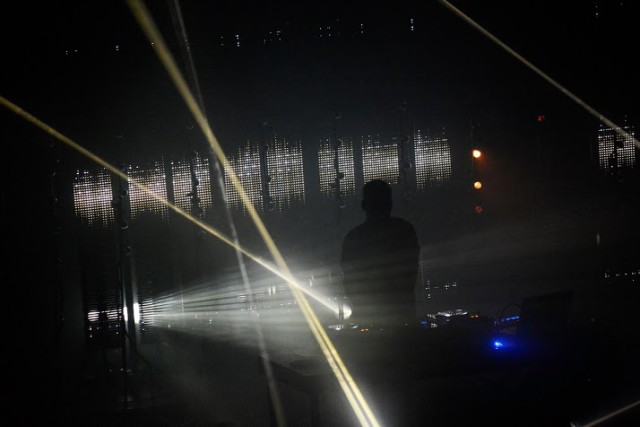
Lil’ Jon’s fateful question wasn’t meant to have an answer. In the progression of highs and lows, build-ups and drops, a DJ set doesn’t give you a reason to turn down. A constant cycle of stimulation at a heightened pace might seem invigorating but really gets repetitive. There is a mindless aliveness in the endless energy of blasted electronic sounds, a feeling often paired with one’s favorite form of intoxication. Or so is my expectation of a DJ set. Having listened to Bonobo, I had a hard time fitting these expectations of a DJ performance to his music. Bonobo is surely a DJ, but not one that fits with Lil’ Jon’s hyping. Rather than cyclical, Bonobo’s music is additive—a rhythm sets the base for the slow construction of an audial landscape that is luscious yet subtle. This music has long been interesting to me, but the idea of a Bonobo concert was a little confusing. I never imagined dancing to Bonobo, becoming excited by Bonobo. As a result, I decided to clear my uncertainty.
Known for his deep bass lines, gradual progressions and creative sampling, Bonobo is Simon Green’s most successful experiment as a DJ. This sampling is particularly interesting—odd organic noises, uncommon instruments and unconventional percussion build upon more standard electronic sounds, often creating a sense of compelling weirdness reminiscent of John Cage’s prepared piano. Fascinating of course, but again, not what I generally expect out of an exciting live DJ set. I was expecting an energetic and closely packed crowd, lots of crazy lights and smoke (different kinds of smoke) and other staples of electronic concerts. I still couldn’t fit the music. I predicted everyone turning up. I wasn’t sure, however, for what.
Jeremy Sole opened for the concert, quickly setting the tone of finding harmony through disparity. Sole connected the world through his music—his set stitched together a variety of ethnic and cultural rhythmic beats. Music from India, Cuba, and American swing was cut and pasted into an electronic structure, unifying a variety of genres under a seamless train of progression. Many of the samples represented party music from their respective sources—danceable, energetic. The experience was loosening; it was fun without being overwhelming. The audience seemed to be going along with it more intensely than I was. There was dancing, cheering, smoking, drinking, grinding and overall great excitement. The musical structure was more aligned with my expectations of a DJ set than my thoughts on Bonobo, but I felt the tone was an appropriate introduction. Sole’s act served as an explicit presentation of themes embedded more subtly in Bonobo’s act.

My preconception of Bonobo’s music was challenged as soon as he hit the stage. The acoustics of the venue dramatically amplified the bass and I began to notice a more clear rhythmic beat akin to Sole’s world sounds. This emphasis made Bonobo’s music more danceable, and the audience was certainly swept in. I began to recognize samples from a similar array of cultures introduced by Sole, finding Bonobo’s music to have strong ethnic references in sound but not genre or structure. The calm build up of Bonobo’s soundscapes suddenly was lined by a primal base; the music seemed more appropriate for an excited crowd. This effect, however, did not entirely transform Bonobo’s style. Bonobo stuck true to the calmness and subtlety of his work throughout much of the performance. These moments of ambiguity—when the expectations of a concert were broken and the music instead asked for calm attention—created curious reflections throughout the audience. I would often look back and see hints of confusion. Some people would interrupt their dancing as they awkwardly struggled with how to react to an unclearly structured transition.
I came into the concert uncertain of how Bonobo would present his work in a context disparate from his own style. There was some streamlining—the music was performed to emphasize its underlying rhythm—but it wasn’t fundamentally changed. This choice periodically interrupted the turning up of the audience, begging to make the concert about the music rather than the expected experience. The high energy of the concert—the lights, the people, the volume—was not at expense to this focus. One could easily be lost in the experience, and many were. Bonobo’s set, however, was so successful in representing and augmenting his previous works that one was rewarded for paying attention, for taking periodic moments to listen. The subtlety of his audio landscapes in their carefully slow construction was present if you chose to be present as well.

Bonobo’s concert certainly challenged my expectations of a DJ set. Though my uncertainty was never fully resolved, I began to understand how the high energy rave could be compromised with music that pledged to be less formulaic. The experience of what I define as the iconic electronic concert is an efficient exchange, providing the greatest, most overwhelming feelings without the need of thought and reflection. Bonobo’s music is not efficient. From its inefficiency comes flourish that draws me into its carefully increasing depth. Bonobo’s performance attempted to bridge these two approaches, allowing intervals of invigorating excitement and meditative appreciation. Though it can be fun to jump, dance, grind, drink, smoke and cheer, it is worth turning down for Bonobo. At least a little bit.
***
Photo credit: Gabe Haro
